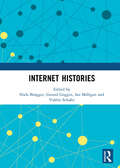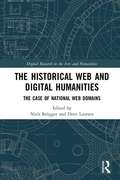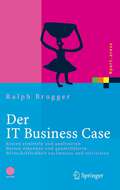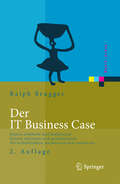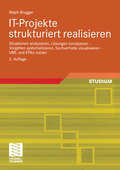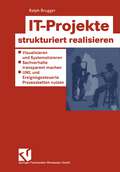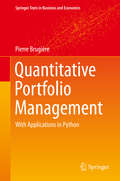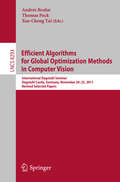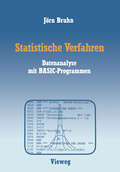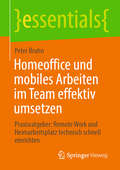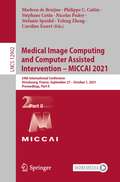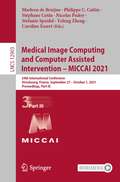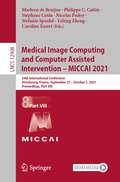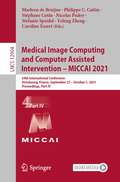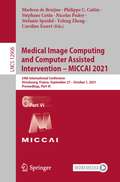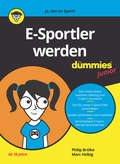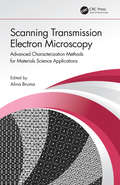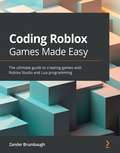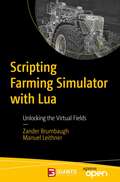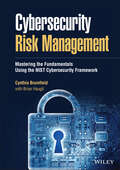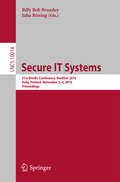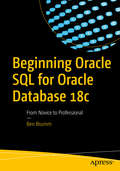- Table View
- List View
Internet Histories
by Niels Brügger Gerard Goggin Ian Milligan Valérie SchaferIn 2017, the new journal Internet Histories was founded. As part of the process of defining a new field, the journal editors approached leading scholars in this dynamic, interdisciplinary area. This book is thus a collection of eighteen short thought-provoking pieces, inviting discussion about Internet histories. They raise and suggest current and future issues in the scholarship, as well as exploring the challenges, opportunities, and tensions that underpin the research terrain. The book explores cultural, political, social, economic, and industrial dynamics, all part of a distinctive historiographical and theoretical approach which underpins this emerging field.The international specialists reflect upon the scholarly scene, laying out the field’s research successes to date, as well as suggest the future possibilities that lie ahead in the field of Internet histories. While the emphasis is on researcher perspectives, interviews with leading luminaries of the Internet’s development are also provided. As histories of the Internet become increasingly important, Internet Histories is a useful roadmap for those contemplating how we can write such works. One cannot write many histories of the 1990s or later without thinking of digital media – and we hope that Internet Histories will be an invaluable resource for such studies. This book was originally published as the first issue of the Internet Histories journal.
The Historical Web and Digital Humanities: The Case of National Web Domains (Digital Research In The Arts And Humanities Ser.)
by Niels Brügger Ditte LaursenThe Historical Web and Digital Humanities fosters discussions between the Digital Humanities and web archive studies by focussing on one of the largest entities of the web, namely national and transnational web domains such as the British, French, or European web. With a view to investigating whether, and how, web studies and web historiography can inform and contribute to the Digital Humanities, this volume contains a number of case studies and methodological and theoretical discussions that both illustrate the potential of studying the web, in this case national web domains, and provide an insight into the challenges associated with doing so. Commentary on and possible solutions to these challenges are debated within the chapters and each one contributes in its own way to a web history in the making that acknowledges the specificities of the archived web. The Historical Web and Digital Humanities will be essential reading for those with an interest in how the past of the web can be studied, as well as how Big Data approaches can be applied to the archived web. As a result, this volume will appeal to academics and students working and studying in the fields of Digital Humanities, internet and media studies, history, cultural studies, and communication.
The Historical Web and Digital Humanities: The Case of National Web Domains (Digital Research In The Arts And Humanities Ser.)
by Niels Brügger Ditte LaursenThe Historical Web and Digital Humanities fosters discussions between the Digital Humanities and web archive studies by focussing on one of the largest entities of the web, namely national and transnational web domains such as the British, French, or European web. With a view to investigating whether, and how, web studies and web historiography can inform and contribute to the Digital Humanities, this volume contains a number of case studies and methodological and theoretical discussions that both illustrate the potential of studying the web, in this case national web domains, and provide an insight into the challenges associated with doing so. Commentary on and possible solutions to these challenges are debated within the chapters and each one contributes in its own way to a web history in the making that acknowledges the specificities of the archived web. The Historical Web and Digital Humanities will be essential reading for those with an interest in how the past of the web can be studied, as well as how Big Data approaches can be applied to the archived web. As a result, this volume will appeal to academics and students working and studying in the fields of Digital Humanities, internet and media studies, history, cultural studies, and communication.
Der IT Business Case: Kosten erfassen und analysieren - Nutzen erkennen und quantifizieren - Wirtschaftlichkeit nachweisen und realisieren (Xpert.press)
by Ralf BruggerObwohl sich das Potential der Informationstechnologie in den letzten Ja- zehnten vervielfacht hat und dadurch die Informatik zweifelsfrei an Bed- tung gewonnen hat, hat sich eines nicht verändert – die Tatsache, dass die Informatik primär als Kostenverursacher wahrgenommen wird. Wenn es um die Kosten geht, hat die Informatik ein angeschlagenes Image. Viele Unternehmenslenker assoziieren Informationstechnologie mit einem - durchsichtigen „Technologie-Schwamm“, der problemlos in der Lage ist, jedes auch noch so hohe Budget zu absorbieren – wobei der Rückfluss in den meisten Fällen ungewiss ist. Die Informatik begegnet diesem Bild, indem sie der Unternehmensf- rung eine zu eindimensionale Sichtweise vorwirft und auf die qualitativen Aspekte ihrer Arbeit verweist. So ist beispielsweise die Rede von „in- grierter Information“, „schnellerer Verfügbarkeit“, „höherer Automatis- rung“, „effizienteren Prozessen“, „größerer Flexibilität“, „stärkerer In- gration“, „einheitlicher Architektur“, „erhöhter Transparenz“ und „weniger Medienbrüchen“. Diese Argumentationsstrategie trägt jedoch nicht wirklich dazu bei, die an die Informatik gerichteten Vorwürfe der intransparenten Wertgener- rung zu entkräften. Die qualitativen Merkmale werden von der Geschäf- leitung kaum wahrgenommen. Die schwache Akzeptanz von qualitativen Auswirkungen beruht zum einen auf der mangelnden Transparenz dieser Eigenschaften. Ein ursächlicher Zusammenhang zwischen den investierten Ressourcen (sowohl in finanzieller, als auch in personeller Hinsicht) und den erzielten Qualitätsmerkmalen ist nur schwer ersichtlich. Noch sch- rer nachvollziehbar ist gar der Einfluss von Informatik-Ausgaben auf das Unternehmensresultat. Doch was schlussendlich zählt, ist nun einmal das Geschäftsergebnis – und dieses wird zunächst durch die IT-Kosten - schmälert.
Der IT Business Case: Kosten erfassen und analysieren - Nutzen erkennen und quantifizieren - Wirtschaftlichkeit nachweisen und realisieren (Xpert.press)
by Ralf BruggerWie jede Unternehmensfunktion muss auch die Informationstechnik (IT) ihren finanziellen Wertbeitrag nachweisen. Dafür bedarf es eines Brückenschlags zwischen Grundsätzen des finanziellen Managements einerseits und Merkmalen der Informationstechnologie andererseits. Diese Verbindung stellt der Autor her, indem er IT-orientiertes Finanzwissen vermittelt und aufzeigt, wie die Forderung nach einer wirtschaftlichen Positionierung der IT in die Tat umgesetzt werden kann. Die 2. Auflage wurde korrigiert und um das Thema Opportunitätskosten erweitert.
IT-Projekte strukturiert realisieren: Situationen analysieren, Lösungen konzipieren — Vorgehen systematisieren, Sachverhalte visualisieren — UML und EPKs nutzen
by Ralph BruggerDieses Buch zeigt, wie man die Aufgabenstellungen von IT-Projekten durch eine systematische Herangehensweise analysieren und grafisch aufbereiten kann. Zunächst geht es darum, durch analytisches Visualisieren ein besseres Aufgabenverständnis zu erreichen. Des Weiteren wird beschrieben wie Lösungen konzeptionell ausgearbeitet und mittels geeigneter Darstellungen kommuniziert werden können. Das Buch hilft in allen Stufen des Projektvorgehens durch zweckmäßige Systematisierungen. Im Vordergrund steht immer der Nutzen in der Praxis, um Sachverhalte klar, effektiv und unmissverständlich zu kommunizieren: Die Basis für den Erfolg in IT-Projekten.
IT-Projekte strukturiert realisieren: Visualisieren und Systematisieren - Sachverhalte transparent machen - UML und Ereignisgesteuerte Prozessketten nutzen
by Ralph BruggerDieses Buch zeigt, wie man die Aufgabenstellungen von IT-Projekten durch eine systematische Herangehensweise analysieren und grafisch darstellen kann.
Quantitative Portfolio Management: with Applications in Python (Springer Texts in Business and Economics)
by Pierre BrugièreThis self-contained book presents the main techniques of quantitative portfolio management and associated statistical methods in a very didactic and structured way, in a minimum number of pages. The concepts of investment portfolios, self-financing portfolios and absence of arbitrage opportunities are extensively used and enable the translation of all the mathematical concepts in an easily interpretable way. All the results, tested with Python programs, are demonstrated rigorously, often using geometric approaches for optimization problems and intrinsic approaches for statistical methods, leading to unusually short and elegant proofs. The statistical methods concern both parametric and non-parametric estimators and, to estimate the factors of a model, principal component analysis is explained. The presented Python code and web scraping techniques also make it possible to test the presented concepts on market data. This book will be useful for teaching Masters students and for professionals in asset management, and will be of interest to academics who want to explore a field in which they are not specialists. The ideal pre-requisites consist of undergraduate probability and statistics and a familiarity with linear algebra and matrix manipulation. Those who want to run the code will have to install Python on their pc, or alternatively can use Google Colab on the cloud. Professionals will need to have a quantitative background, being either portfolio managers or risk managers, or potentially quants wanting to double check their understanding of the subject.
Efficient Algorithms for Global Optimization Methods in Computer Vision: International Dagstuhl Seminar, Dagstuhl Castle, Germany, November 20-25, 2011, Revised Selected Papers (Lecture Notes in Computer Science #8293)
by Andrés Bruhn Thomas Pock Xue-Cheng TaiThis book constitutes the thoroughly refereed post-conference proceedings of the International Dagstuhl-Seminar on Efficient Algorithms for Global Optimization Methods in Computer Vision, held in Dagstuhl Castle, Germany, in November 2011. The 8 revised full papers presented were carefully reviewed and selected by 12 lectures given at the seminar. The seminar focused on the entire algorithmic development pipeline for global optimization problems in computer vision: modelling, mathematical analysis, numerical solvers and parallelization. In particular, the goal of the seminar was to bring together researchers from all four fields to analyze and discuss the connections between the different stages of the algorithmic design pipeline.
Statistische Verfahren: Datenanalyse mit BASIC-Programmen
by Jörn BruhnBei der Planung und Auswertung naturwissenschaftlicher und technischer Versuche sowie sozialwissenschaftlicher Untersuchungen werden wesentlich statistische Verfahren ein gesetzt. Zu einer vollständigen statistischen Untersuchung gehören: 1) Formulierung des Problems und der daraus resultierenden Fragen und Hypothesen, 2) Planung und Beschreibung des Untersuchungsplans, 3) Ausführung des Experiments bzw. der statistischen Erhebung, 4) Tabellierung und Beschreibung der empirischen Ergebnisse, Berechnung von Kennwerten, 5) Schlußfolgerungen und Interpretationen. Insbesondere mit den Schritten (4) und (5) ist oft ein erheblicher Rechenaufwand verbun den, der sich mit Papier und Bleistift oft nur mühsam abwickeln läßt. Dieser kann sinnvoll von einem Home-oder Personal-Computer übernommen werden. Einfach zu bedienende Computerprogramme erledigen heute in Bruchteilen von Sekun den, was früher längere Arbeit in Anspruch nahm. Zudem wird der Anwender von Pro blemen der numerischen Mathematik verschont und kann sich an deren Stelle wesent licheren Aspekten der Methode widmen. Die Zusammenarbeit mit verschiedenen Anwendern hat gezeigt, daß es möglich ist, ein Verständnis statistischer Verfahren auch bei Nicht-Statistikern zu erwecken. Dabei muß nur die Kenntnis einfacher mathematischer Begriffe sowie der wichtigsten Methoden der Statistik vorausgesetzt werden.
Homeoffice und mobiles Arbeiten im Team effektiv umsetzen: Praxisratgeber: Remote Work und Heimarbeitsplatz technisch schnell einrichten (essentials)
by Peter BruhnProduktives Arbeiten im Homeoffice erfordert neben richtiger Ausstattung, guter Sprach- und Datenkommunikation und Zugriff auf Daten auch die – durch IT-Tools unterstützten – passenden Führungs- und Arbeitsmethoden. Dieser Ratgeber bietet konkrete Anleitungen, um ohne IT-Fachkenntnisse das weltweite Arbeiten im Team schnell und pragmatisch möglich zu machen.
Medical Image Computing and Computer Assisted Intervention – MICCAI 2021: 24th International Conference, Strasbourg, France, September 27–October 1, 2021, Proceedings, Part II (Lecture Notes in Computer Science #12902)
by Marleen De Bruijne Philippe C. Cattin Stéphane Cotin Nicolas Padoy Stefanie Speidel Yefeng Zheng Caroline EssertThe eight-volume set LNCS 12901, 12902, 12903, 12904, 12905, 12906, 12907, and 12908 constitutes the refereed proceedings of the 24th International Conference on Medical Image Computing and Computer-Assisted Intervention, MICCAI 2021, held in Strasbourg, France, in September/October 2021.*The 542 revised full papers presented were carefully reviewed and selected from 1809 submissions in a double-blind review process. The papers are organized in the following topical sections: Part I: image segmentation Part II: machine learning - self-supervised learning; machine learning - semi-supervised learning; and machine learning - weakly supervised learning Part III: machine learning - advances in machine learning theory; machine learning - domain adaptation; machine learning - federated learning; machine learning - interpretability / explainability; and machine learning - uncertainty Part IV: image registration; image-guided interventions and surgery; surgical data science; surgical planning and simulation; surgical skill and work flow analysis; and surgical visualization and mixed, augmented and virtual reality Part V: computer aided diagnosis; integration of imaging with non-imaging biomarkers; and outcome/disease prediction Part VI: image reconstruction; clinical applications - cardiac; and clinical applications - vascular Part VII: clinical applications - abdomen; clinical applications - breast; clinical applications - dermatology; clinical applications - fetal imaging; clinical applications - lung; clinical applications - neuroimaging - brain development; clinical applications - neuroimaging - DWI and tractography; clinical applications - neuroimaging - functional brain networks; clinical applications - neuroimaging – others; and clinical applications - oncology Part VIII: clinical applications - ophthalmology; computational (integrative) pathology; modalities - microscopy; modalities - histopathology; and modalities - ultrasound*The conference was held virtually.
Medical Image Computing and Computer Assisted Intervention – MICCAI 2021: 24th International Conference, Strasbourg, France, September 27–October 1, 2021, Proceedings, Part III (Lecture Notes in Computer Science #12903)
by Marleen De Bruijne Philippe C. Cattin Stéphane Cotin Nicolas Padoy Stefanie Speidel Yefeng Zheng Caroline EssertThe eight-volume set LNCS 12901, 12902, 12903, 12904, 12905, 12906, 12907, and 12908 constitutes the refereed proceedings of the 24th International Conference on Medical Image Computing and Computer-Assisted Intervention, MICCAI 2021, held in Strasbourg, France, in September/October 2021.*The 542 revised full papers presented were carefully reviewed and selected from 1809 submissions in a double-blind review process. The papers are organized in the following topical sections: Part I: image segmentation Part II: machine learning - self-supervised learning; machine learning - semi-supervised learning; and machine learning - weakly supervised learning Part III: machine learning - advances in machine learning theory; machine learning - domain adaptation; machine learning - federated learning; machine learning - interpretability / explainability; and machine learning - uncertainty Part IV: image registration; image-guided interventions and surgery; surgical data science; surgical planning and simulation; surgical skill and work flow analysis; and surgical visualization and mixed, augmented and virtual reality Part V: computer aided diagnosis; integration of imaging with non-imaging biomarkers; and outcome/disease prediction Part VI: image reconstruction; clinical applications - cardiac; and clinical applications - vascular Part VII: clinical applications - abdomen; clinical applications - breast; clinical applications - dermatology; clinical applications - fetal imaging; clinical applications - lung; clinical applications - neuroimaging - brain development; clinical applications - neuroimaging - DWI and tractography; clinical applications - neuroimaging - functional brain networks; clinical applications - neuroimaging – others; and clinical applications - oncology Part VIII: clinical applications - ophthalmology; computational (integrative) pathology; modalities - microscopy; modalities - histopathology; and modalities - ultrasound*The conference was held virtually.
Medical Image Computing and Computer Assisted Intervention – MICCAI 2021: 24th International Conference, Strasbourg, France, September 27 – October 1, 2021, Proceedings, Part VIII (Lecture Notes in Computer Science #12908)
by Marleen De Bruijne Philippe C. Cattin Stéphane Cotin Nicolas Padoy Stefanie Speidel Yefeng Zheng Caroline EssertThe eight-volume set LNCS 12901, 12902, 12903, 12904, 12905, 12906, 12907, and 12908 constitutes the refereed proceedings of the 24th International Conference on Medical Image Computing and Computer-Assisted Intervention, MICCAI 2021, held in Strasbourg, France, in September/October 2021.*The 542 revised full papers presented were carefully reviewed and selected from 1809 submissions in a double-blind review process. The papers are organized in the following topical sections: Part I: image segmentation Part II: machine learning - self-supervised learning; machine learning - semi-supervised learning; and machine learning - weakly supervised learning Part III: machine learning - advances in machine learning theory; machine learning - domain adaptation; machine learning - federated learning; machine learning - interpretability / explainability; and machine learning - uncertainty Part IV: image registration; image-guided interventions and surgery; surgical data science; surgical planning and simulation; surgical skill and work flow analysis; and surgical visualization and mixed, augmented and virtual reality Part V: computer aided diagnosis; integration of imaging with non-imaging biomarkers; and outcome/disease prediction Part VI: image reconstruction; clinical applications - cardiac; and clinical applications - vascular Part VII: clinical applications - abdomen; clinical applications - breast; clinical applications - dermatology; clinical applications - fetal imaging; clinical applications - lung; clinical applications - neuroimaging - brain development; clinical applications - neuroimaging - DWI and tractography; clinical applications - neuroimaging - functional brain networks; clinical applications - neuroimaging – others; and clinical applications - oncology Part VIII: clinical applications - ophthalmology; computational (integrative) pathology; modalities - microscopy; modalities - histopathology; and modalities - ultrasound*The conference was held virtually.
Medical Image Computing and Computer Assisted Intervention – MICCAI 2021: 24th International Conference, Strasbourg, France, September 27–October 1, 2021, Proceedings, Part IV (Lecture Notes in Computer Science #12904)
by Marleen De Bruijne Philippe C. Cattin Stéphane Cotin Nicolas Padoy Stefanie Speidel Yefeng Zheng Caroline EssertThe eight-volume set LNCS 12901, 12902, 12903, 12904, 12905, 12906, 12907, and 12908 constitutes the refereed proceedings of the 24th International Conference on Medical Image Computing and Computer-Assisted Intervention, MICCAI 2021, held in Strasbourg, France, in September/October 2021.*The 542 revised full papers presented were carefully reviewed and selected from 1809 submissions in a double-blind review process. The papers are organized in the following topical sections: Part I: image segmentation Part II: machine learning - self-supervised learning; machine learning - semi-supervised learning; and machine learning - weakly supervised learning Part III: machine learning - advances in machine learning theory; machine learning - domain adaptation; machine learning - federated learning; machine learning - interpretability / explainability; and machine learning - uncertainty Part IV: image registration; image-guided interventions and surgery; surgical data science; surgical planning and simulation; surgical skill and work flow analysis; and surgical visualization and mixed, augmented and virtual reality Part V: computer aided diagnosis; integration of imaging with non-imaging biomarkers; and outcome/disease prediction Part VI: image reconstruction; clinical applications - cardiac; and clinical applications - vascular Part VII: clinical applications - abdomen; clinical applications - breast; clinical applications - dermatology; clinical applications - fetal imaging; clinical applications - lung; clinical applications - neuroimaging - brain development; clinical applications - neuroimaging - DWI and tractography; clinical applications - neuroimaging - functional brain networks; clinical applications - neuroimaging – others; and clinical applications - oncology Part VIII: clinical applications - ophthalmology; computational (integrative) pathology; modalities - microscopy; modalities - histopathology; and modalities - ultrasound*The conference was held virtually.
Medical Image Computing and Computer Assisted Intervention – MICCAI 2021: 24th International Conference, Strasbourg, France, September 27–October 1, 2021, Proceedings, Part VI (Lecture Notes in Computer Science #12906)
by Marleen De Bruijne Philippe C. Cattin Stéphane Cotin Nicolas Padoy Stefanie Speidel Yefeng Zheng Caroline EssertThe eight-volume set LNCS 12901, 12902, 12903, 12904, 12905, 12906, 12907, and 12908 constitutes the refereed proceedings of the 24th International Conference on Medical Image Computing and Computer-Assisted Intervention, MICCAI 2021, held in Strasbourg, France, in September/October 2021.*The 531 revised full papers presented were carefully reviewed and selected from 1630 submissions in a double-blind review process. The papers are organized in the following topical sections: Part I: image segmentation Part II: machine learning - self-supervised learning; machine learning - semi-supervised learning; and machine learning - weakly supervised learning Part III: machine learning - advances in machine learning theory; machine learning - attention models; machine learning - domain adaptation; machine learning - federated learning; machine learning - interpretability / explainability; and machine learning - uncertainty Part IV: image registration; image-guided interventions and surgery; surgical data science; surgical planning and simulation; surgical skill and work flow analysis; and surgical visualization and mixed, augmented and virtual reality Part V: computer aided diagnosis; integration of imaging with non-imaging biomarkers; and outcome/disease prediction Part VI: image reconstruction; clinical applications - cardiac; and clinical applications - vascular Part VII: clinical applications - abdomen; clinical applications - breast; clinical applications - dermatology; clinical applications - fetal imaging; clinical applications - lung; clinical applications - neuroimaging - brain development; clinical applications - neuroimaging - DWI and tractography; clinical applications - neuroimaging - functional brain networks; clinical applications - neuroimaging – others; and clinical applications - oncology Part VIII: clinical applications - ophthalmology; computational (integrative) pathology; modalities - microscopy; modalities - histopathology; and modalities - ultrasound*The conference was held virtually.
E-Sportler Werden für Dummies Junior (Für Dummies)
by Philip Brulke Marc HelbigIn diesem Buch erfährst du, wie aus "Daddeln" und "Zocken" professioneller E-Sport wird: Welches Spiel, welcher Titel passt zu dir? Wie und wann solltest du trainieren? Wie gehst du mit Niederlagen um? Was kannst du aus Fehlern lernen? Außerdem erfährst du, dass es neben dem Job als Spieler noch weitere Berufe im E-Sport gibt und wie du dich auf diese vorbereiten kannst. Und auch wenn du den E-Sport nicht als Profi betreiben und auch nicht in diesem Bereich arbeiten willst, wirst du beim Spielen einfach besser werden. Denn auch Hobbysportler wollen doch gewinnen, oder? Bestens geeignet für Kinder und Jugendliche ab 10 Jahren.
Scanning Transmission Electron Microscopy: Advanced Characterization Methods for Materials Science Applications
by Alina BrumaScanning Transmission Electron Microscopy is focused on discussing the latest approaches in the recording of high-fidelity quantitative annular dark-field (ADF) data. It showcases the application of machine learning in electron microscopy and the latest advancements in image processing and data interpretation for materials notoriously difficult to analyze using scanning transmission electron microscopy (STEM). It also highlights strategies to record and interpret large electron diffraction datasets for the analysis of nanostructures. This book: Discusses existing approaches for experimental design in the recording of high-fidelity quantitative ADF data Presents the most common types of scintillator-photomultiplier ADF detectors, along with their strengths and weaknesses. Proposes strategies to minimize the introduction of errors from these detectors and avenues for dealing with residual errors Discusses the practice of reliable multiframe imaging, along with the benefits and new experimental opportunities it presents in electron dose or dose-rate management Focuses on supervised and unsupervised machine learning for electron microscopy Discusses open data formats, community-driven software, and data repositories Proposes methods to process information at both global and local scales, and discusses avenues to improve the storage, transfer, analysis, and interpretation of multidimensional datasets Provides the spectrum of possibilities to study materials at the resolution limit by means of new developments in instrumentation Recommends methods for quantitative structural characterization of sensitive nanomaterials using electron diffraction techniques and describes strategies to collect electron diffraction patterns for such materials This book helps academics, researchers, and industry professionals in materials science, chemistry, physics, and related fields to understand and apply computer-science–derived analysis methods to solve problems regarding data analysis and interpretation of materials properties.
Scanning Transmission Electron Microscopy: Advanced Characterization Methods for Materials Science Applications
by Alina BrumaScanning Transmission Electron Microscopy is focused on discussing the latest approaches in the recording of high-fidelity quantitative annular dark-field (ADF) data. It showcases the application of machine learning in electron microscopy and the latest advancements in image processing and data interpretation for materials notoriously difficult to analyze using scanning transmission electron microscopy (STEM). It also highlights strategies to record and interpret large electron diffraction datasets for the analysis of nanostructures. This book: Discusses existing approaches for experimental design in the recording of high-fidelity quantitative ADF data Presents the most common types of scintillator-photomultiplier ADF detectors, along with their strengths and weaknesses. Proposes strategies to minimize the introduction of errors from these detectors and avenues for dealing with residual errors Discusses the practice of reliable multiframe imaging, along with the benefits and new experimental opportunities it presents in electron dose or dose-rate management Focuses on supervised and unsupervised machine learning for electron microscopy Discusses open data formats, community-driven software, and data repositories Proposes methods to process information at both global and local scales, and discusses avenues to improve the storage, transfer, analysis, and interpretation of multidimensional datasets Provides the spectrum of possibilities to study materials at the resolution limit by means of new developments in instrumentation Recommends methods for quantitative structural characterization of sensitive nanomaterials using electron diffraction techniques and describes strategies to collect electron diffraction patterns for such materials This book helps academics, researchers, and industry professionals in materials science, chemistry, physics, and related fields to understand and apply computer-science–derived analysis methods to solve problems regarding data analysis and interpretation of materials properties.
Coding Roblox Games Made Easy: The ultimate guide to creating games with Roblox Studio and Lua programming
by Zander BrumbaughGet up and running with Roblox development with the help of expert guidance for working with Roblox components and Lua programmingKey FeaturesDiscover solutions to common problems faced while creating games on RobloxExplore tips, tricks, and best practices and learn advanced Roblox coding techniques to create gamesUnderstand how to program in the Roblox Lua language, add engaging effects, add a variety of functionalities, and much moreBook DescriptionRoblox is a global virtual platform like no other for both playing and creating games. With well over 150 million monthly active users, Roblox hosts all genres of games that can be played by other members of the community using the Lua programming language. Not only can you create games for free, but you can also earn considerable sums of money if from the success of your games, and become part of the vast and supportive developer circle that provides excellent opportunities for networking in a tight-knit community. With this practical book, you'll get hands-on experience working on the Roblox platform. You'll start with an overview of Roblox development and then understand how to use Roblox Studio. As you progress, you'll gradually learn everything you need from how to program in Roblox Lua to creating Obby and Battle Royale games. Finally, you'll delve into the logistics of game production, focusing on optimizing the performance of your game by implementing impressive mechanics, monetization, and marketing practices. By the end of this Roblox book, you'll be able to lead or work with a team to bring your gaming world to life, and extend that experience to players around the world.What you will learnGet started with Roblox development and explore aspects such as choosing a developer typeUnderstand how to use Roblox Studio and other free resourcesCreate your first game with the Roblox Lua programming languageBecome well-versed with the three Ms - Mechanics, Monetization, and MarketingDevelop real-world games such as Battle Royale and ObbyDiscover expert tips for collaborating effectively and managing project workloadsWho this book is forThis Roblox guide is for anyone interested in learning how to develop games on the Roblox platform. If you're already familiar with Roblox and looking for tips, tricks, and Roblox and Lua best practices for efficient development, you'll find this book helpful.
Scripting Farming Simulator with Lua: Unlocking the Virtual Fields
by Zander Brumbaugh Manuel LeithnerCreate mods using the popular game Farming Simulator with Lua, a versatile scripting language that can run on various platforms and applications. This open access book is best suited for programmers who want to learn how to use Lua to write scripts that can enhance and extend the gameplay experience.You'll start by reviewing the basics of programming in Lua and then move on to advanced topics, such as object-oriented programming, vehicle and placeable specializations, network synchronization, and creating custom user interfaces. With step-by-step instructions and detailed explanations, you'll see how to create scripts that modify game mechanics and add new features to the game.The practical examples and projects are ideal for providing hands-on experience with Lua scripting. Whether you are a creator looking to take your skills to the next level or a game developer interested in learning a new programming language, Scripting Farming Simulator with Lua is the ultimate guide to mastering Lua scripting.What You'll LearnUnderstand the fundamentals of programming in LUAImplement a basic “Hello-World” modAdd a new graphical user interface to your modUse hook scripts to extend base game featuresPublish your mod on the official Farming Simulator ModHub Who This Book Is ForCreators who want to add new features to Farming Simulator; game developers who want to learn a new programming language for modding purposes, and anyone who wants to expand their knowledge of programming and scripting.
Cybersecurity Risk Management: Mastering the Fundamentals Using the NIST Cybersecurity Framework
by Cynthia BrumfieldCybersecurity Risk Management In Cybersecurity Risk Management: Mastering the Fundamentals Using the NIST Cybersecurity Framework, veteran technology analyst Cynthia Brumfield, with contributions from cybersecurity expert Brian Haugli, delivers a straightforward and up-to-date exploration of the fundamentals of cybersecurity risk planning and management. The book offers readers easy-to-understand overviews of cybersecurity risk management principles, user, and network infrastructure planning, as well as the tools and techniques for detecting cyberattacks. The book also provides a roadmap to the development of a continuity of operations plan in the event of a cyberattack. With incisive insights into the Framework for Improving Cybersecurity of Critical Infrastructure produced by the United States National Institute of Standards and Technology (NIST), Cybersecurity Risk Management presents the gold standard in practical guidance for the implementation of risk management best practices. Filled with clear and easy-to-follow advice, this book also offers readers: A concise introduction to the principles of cybersecurity risk management and the steps necessary to manage digital risk to systems, assets, data, and capabilities A valuable exploration of modern tools that can improve an organization’s network infrastructure protection A practical discussion of the challenges involved in detecting and responding to a cyberattack and the importance of continuous security monitoring A helpful examination of the recovery from cybersecurity incidents Perfect for undergraduate and graduate students studying cybersecurity, Cybersecurity Risk Management is also an ideal resource for IT professionals working in private sector and government organizations worldwide who are considering implementing, or who may be required to implement, the NIST Framework at their organization.
Cybersecurity Risk Management: Mastering the Fundamentals Using the NIST Cybersecurity Framework
by Cynthia BrumfieldCybersecurity Risk Management In Cybersecurity Risk Management: Mastering the Fundamentals Using the NIST Cybersecurity Framework, veteran technology analyst Cynthia Brumfield, with contributions from cybersecurity expert Brian Haugli, delivers a straightforward and up-to-date exploration of the fundamentals of cybersecurity risk planning and management. The book offers readers easy-to-understand overviews of cybersecurity risk management principles, user, and network infrastructure planning, as well as the tools and techniques for detecting cyberattacks. The book also provides a roadmap to the development of a continuity of operations plan in the event of a cyberattack. With incisive insights into the Framework for Improving Cybersecurity of Critical Infrastructure produced by the United States National Institute of Standards and Technology (NIST), Cybersecurity Risk Management presents the gold standard in practical guidance for the implementation of risk management best practices. Filled with clear and easy-to-follow advice, this book also offers readers: A concise introduction to the principles of cybersecurity risk management and the steps necessary to manage digital risk to systems, assets, data, and capabilities A valuable exploration of modern tools that can improve an organization’s network infrastructure protection A practical discussion of the challenges involved in detecting and responding to a cyberattack and the importance of continuous security monitoring A helpful examination of the recovery from cybersecurity incidents Perfect for undergraduate and graduate students studying cybersecurity, Cybersecurity Risk Management is also an ideal resource for IT professionals working in private sector and government organizations worldwide who are considering implementing, or who may be required to implement, the NIST Framework at their organization.
Secure IT Systems: 21st Nordic Conference, NordSec 2016, Oulu, Finland, November 2-4, 2016. Proceedings (Lecture Notes in Computer Science #10014)
by Billy Bob Brumley Juha RöningThis book constitutes the proceedings of the 21st Nordic Conference on Secure IT Systems, held in Oulu, Finland, in November 2016. The 16 full papers presented in this volume were carefully reviewed and selected from 43 submissions.The focus of the conference is on following topics: Security, System Security, Network Security, Software Security, and Information Security.
Beginning Oracle SQL for Oracle Database 18c: From Novice to Professional
by Ben BrummStart developing with Oracle SQL. This book is a one-stop introduction to everything you need to know about getting started developing an Oracle Database. You'll learn about foundational concepts, setting up a simple schema, adding data, reading data from the database, and making changes. No experience with databases is required to get started. Examples in the book are built around Oracle Live SQL, a freely available, online sandbox for practicing and experimenting with SQL statements, and Oracle Express Edition, a free version of Oracle Database that is available for download.A marquee feature of Beginning Oracle SQL for Oracle Database 18c is the small chapter size. Content is divided into easily digestible chunks that can be read and practiced in very short intervals of time, making this the ideal book for a busy professional to learn from. Even just a 15-20 minute block of free time can be put to good use.Author Ben Brumm begins by helping you understand what a database is, and getting you set up with a sandbox in which to practice the SQL that you are learning. From there, easily digestible chapters cover, point-by-point, the different aspects of writing queries to get data out of a database. You’ll also learn about creating tables and getting data into the database. Crucial topics such as working with nulls and writing analytic queries are given the attention they deserve, helping you to avoid pitfalls when writing queries for production use.What You'll LearnCreate, update, and delete tables in an Oracle databaseAdd, update, delete data from those database tablesQuery and view data stored in your databaseManipulate and transform data using in-built database functions and featuresCorrectly choose when to use Oracle-specific syntax and featuresWho This Book Is ForThose new to Oracle who are planning to develop software using Oracle as the back-end data store. The book is also for those who are getting started in software development and realize they need to learn some kind of database language. Those who are learning software development on the side of their normal job, or learning it as a college student, who are ready to learn what a database is and how to use it also will find this book useful.
